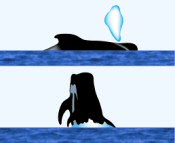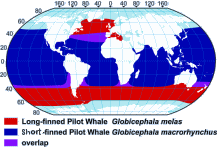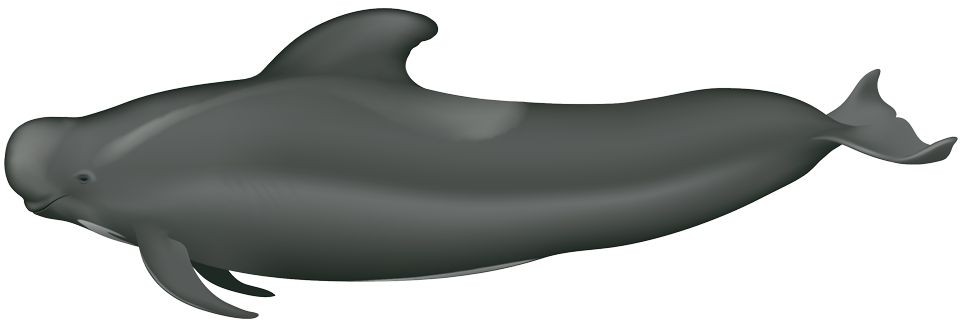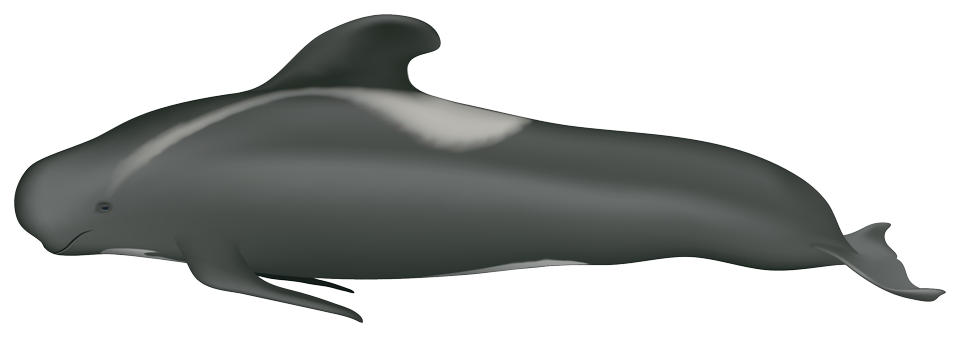Pilot Whale
CLASS: Mammalia
ORDER: Cetacea
SUBORDER: Odontoceti
FAMILY: Delphinidae
GENUS: Globicephala
SPECIES: melas (long-finned) and macrorhynchus (short-finned)
The pilot whale, like the killer whale, is a member of the dolphin family, and is second only to the killer whale in size. Displaying intelligence equal to that of the bottlenose dolphin, the pilot whale is easily trained. One captive pilot whale named Morgan was trained by Navy scientists to retrieve beeper-attached objects from the ocean floor at depths of over 1,600 feet. Carrying a clamping recovery device in his mouth, he attached it to the located object, which was then raised to the surface by compressed air balloons. The pilot whale is extremely social, and is well known for stranding in groups of a few animals to several hundred at a time.
Physical Description
The pilot whale has a distinct rounded head with a very slight beak and an up-curved mouthline. In males the rounded head may protrude up to 4 inches over the lower jaw. Its body is long and stocky, narrowing along the caudal peduncle (tailstock).

Surface Characteristics
Color
Generally all black to coal gray, the pilot whale has a white or light gray anchor-shaped patch on its ventral (bottom) surface. The short-finned pilot whale has a faint gray saddle patch behind the dorsal (top) fin.
Fins and Fluke
Its prominent dorsal (top) fin is located on the forward part of its back, and is falcate (strongly curved) with a long base. Its flippers are sickle shaped and, in the long-finned pilot whale, very long.
Length and Weight
Males are much larger than females. Adult males measure up to 20 feet (6.1 m) and weigh up to 3 tons. Adult females measure up to 16 feet (4.9 m) and weigh up to 1.5 tons.
Feeding
The pilot whale feeds primarily on squid, although it's known to eat octopus, cuttlefish, herring and other small fish when squid is unavailable. It has only 40 to 48 teeth, compared to 120 in many other dolphin species. This may represent an evolutionary trend toward fewer teeth in squid eaters. Its teeth are used only for catching/grasping. An adult pilot whale may eat up to 30 pounds per day. In Newfoundland, pilot whales have been seen hunting in groups to help concentrate their prey. One pod was observed entering a bay in a line, slowly closing the line into a circle, and trapping the prey in the center. Powerful high-pitched whistles appear to be involved in coordinating this activity.
Mating and Breeding
Males reach sexual maturity at about 15 to 16 feet (4.6 m) and 12 years of age. Females reach sexual maturity at about 12 feet (3.7 m) and 6 to 7 years of age. Gestation lasts approximately 12 to15 months and calving occurs once every 3 to 5 years. Calves are generally 6 feet (1.8 m) at birth, and weigh about 225 pounds. The calf nurses for up to 22 months, with some evidence for longer lactation and extensive mother calf bonds. Most calves are born in the summer, though some calving occurs throughout the year. The males may compete for mates with fights involving butting, biting, and ramming. Mating also involves these activities, and some females carry scars from bites inflicted by males during the breeding season. Females have been observed to have calves as late as 35 years old, and lactate as late as 51. This evidence indicates that females may nurse their last calf until puberty (up to 10 years in males).

Range Map
Distribution and Migration
In general, pilot whales are found in both the northern and southern hemispheres, in tropical and temperate waters throughout the world. Short-finned pilot whales tend to be found in warmer waters, while cold and more temperate waters are preferred by the long-finned variety. There are some areas of overlap between the two species, but they remain segregated in most areas.
Natural History
Pilot whales are very social, and are most often found in groups of 20 to 90. Within these groups are at least some stable associations, usually between related females and their offspring. There are usually some males in these groups, but genetic evidence has shown that these males are not the fathers of the calves in the group. Several calves in one group may be fathered by the same male, indicating that a male can enter a group for a brief period and mate with more than one female. Partly because of their social nature, pilot whales are often involved in mass strandings. In this century, mass strandings of as many as several hundred pilot whales at one time have been recorded. Although no one knows why these beachings occur, some may result from persistence to keep the group together. Other reasons may involve mis-navigation when following prey, when traveling (possibly due to irregularities in the magnetic field), or possible parasitic infections resulting in neurological disorders.
Status
Figures for both species of pilot whales are unknown, and even though they are depleted in some areas, pilot whales are not considered to be endangered. There are likely to be almost a million long-finned pilot whales and at least 200,000 short-finned pilot whales worldwide. Humans have taken advantage of the social nature of pilot whales. "Drive fisheries," where groups are herded to the beach for slaughter, have taken place on Cape Cod, Newfoundland, the Faroe, Shetland, and Orkney Islands, Iceland, and Norway. The whales have been killed for meat, bone, fertilizer, and oil. In some places, such as the Faroe Islands, the kill continues today despite an obvious decrease in whale numbers. One drive fishery in Newfoundland killed over 50,000 whales between 1951 and 1961, rapidly decreasing the number of pilot whales in Newfoundland waters. Other kills have not had such a drastic effect. Pilot whales are also being used by man as exhibition animals. They are displayed in many aquariums and zoos.
Bibliography
- Bernard, H.J. and Reilly, S.B. (1999). Pilot whales. In: Handbook of Marine Mammals (S.H. Ridgeway and R. Harrison, eds.), volume 6. Academic Press, London. Pp. 245-279.
- Jefferson, T.A., M.A. Webber, R.L. Pitman. 2015. Marine Mammals of the World: A Comprehensive Guide to their Identification, 2nd edition. Elsevier/AP.
- Olson, P.A. and Reilly, S.B. (2002). Pilot whales. In: Encyclopedia of Marine Mammals (W.F. Perrin, B. Wursig, and J.G.M. Thewissen, eds.). Academic Press, New York. Pp. 898-903.
Acknowledgements
We greatly appreciate the knowledge and assistance of Kate Sardi and Mason Weinrich, both of the Whale Center of New England, who contributed to the revision of this fact sheet. Illustrations courtesy Uko Gorter, copyright ©2017 all rights reserved.
FACT SHEETS MAY BE REPRINTED FOR EDUCATIONAL OR SCIENTIFIC PURPOSES
|




